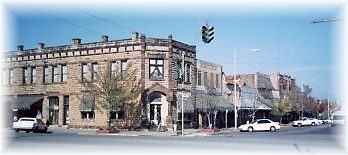
Looking across the Oklahoma prairie, one can imagine scenes once visible to the people of the frontier: No Man's Land, Indian Territory, cowboys, buffalo, and the great rolling plains.
No other Oklahoman exemplified "The Wild West" as did Gordon W. Lillie ...Pawnee Bill. He was born in Illinois in 1860 and became interested in the west as a child. He came to Indian Territory in 1875 and was appointed teacher for the Pawnee Indians in 1879. In 1883, Gordon W. Lillie joined thenewly formed "Buffalo Bill's Wild West Show" as an interpreter and performer. In 1886 he married May Manning, a 15 year old girl from Philadelphia he had met while traveling with the show. In 1888 Pawnee Bill formed his own "Wild West Show" and May became a very popular act in her own right for her marksmanship and riding.
In 1908, Pawnee Bill merged his Wild West Show with the Buffalo Bill Wild West Show and the combined show became know as "The Two Bills' Show." It was billed as the entertainment triumph of the ages and it traveled all over the world entertaining audiences with both realistic and fantasy views of the Old West. The show closed in Denver, Colorado, in 1913 after touring for five seasons as "Buffalo Bill's Wild West and Pawnee Bill's Great Far East Show."
Pawnee Bill, always an entertainer and interested in preserving the Old West for future generations, built "Pawnee Bill's Old Town and Trading Post" two miles west of his buffalo ranch. This tourist attraction was complete with rustic cabins to rent, restaurants featuring buffalo steaks, Indian dancing, Indian tepees and mud lodges, and buffalo grazing in the background. It was the scene of many large statewide celebrations for the boy scouts as well as other organizations and famous people. Old Town burned to the ground in 1944 and with it some of the finest objects of Indian art and artifacts of the Old West were destroyed.
Pawnee Bill died in 1942, just eleven days before his 82nd birthday. Even in his last years, time that had whitened his hair had not dimmed the piercing grey eyes nor the spirit of this old frontiersman. The year before his death he still presented a lithe, immaculate figure in buckskins and wide sombrero. With his long hair touching his shoulder, he still was that picturesque character who, in a varied lifetime, had been a deciding factor in the settlement of the state of Oklahoma.
